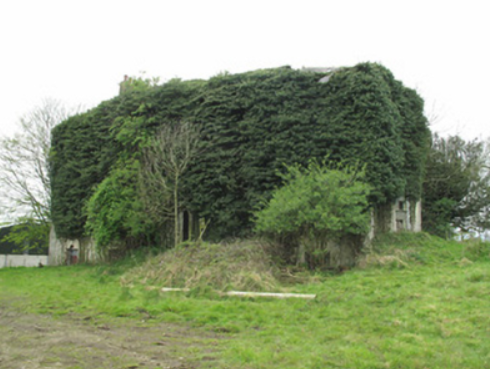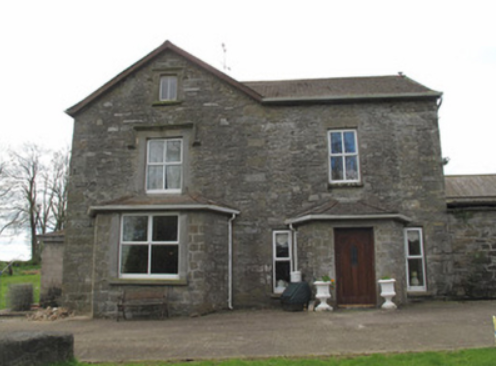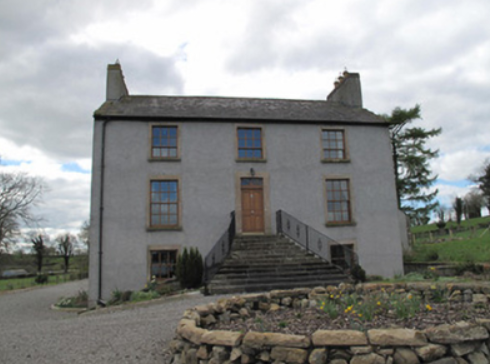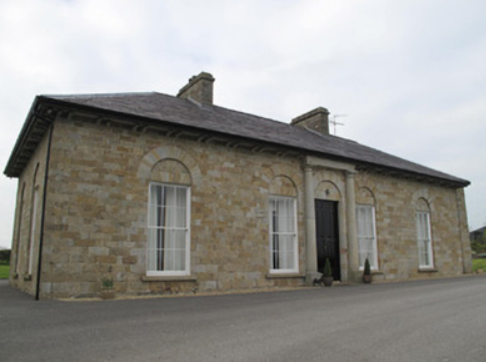Thornhill (Drumsnat)
Houses within 5km of this house
Displaying 18 houses.
Houses within 5km of Thornhill (Drumsnat)
Displaying 18 houses.
| House name | Description | |
|---|---|---|
| Brandrum | An early 18th century house located on the Cole of Florence Court estate. Early residents were Edward Mayne of the Mount Sedborough family and the Reverend Robert Montgomery, whose mother was a Cole. The house was close to another 18th century Montgomery home Ballyleck. It is named on the 1st edition 6 inch Ordnance Survey Map (1836). The Ordnance Survey Field Name Book states that ‘Brandrim is a delightful residence, there is an excellent house with good offices and gardens attached; the grounds well laid out and well planted’. Lewis records Owen Blayney Cole as the proprietor and he was leasing the property to Thomas Coote at the time of Griffith’s Valuation. The buildings were valued at £35. Brandrum was the home of Hugh Gill Patterson and family in the early 20th century. This house is now a ruin. |

|
| Ballyleck | Alexander Montgomery, Member of Parliament for county Tyrone, had this house built in the mid-18th century. By the early 19th century Ballyleck had become part of the estate of the Westenra family, Barons Rossmore. The house is named on the 1st edition 6 inch Ordnance Survey Map (1836). Lewis records the Honourable Richard Westenra as resident. He died in 1838. Circa 1860 William M’Keane was the occupier holding the property from Henrietta Westenra. It was valued at £36. A few years later it had become the home of Jesse Lloyd , a brother of Lady Rossmore. This house with extensive outbuildings was the home of Lucius O’Brien and family in 1901 and of William Black and family in 1911. This house is still extant. |

|
| Clonamully | This house, sometimes spelt Clenamully, was the home of the Fiddes family in the 19th century. Members of the Fiddes family were land agents. Located on the Lewis, formerly Scott estate, it was named on the 1st edition 6 inch Ordnance Survey map (1836) and had a walled garden. The Reverend James Fiddes was rector of the parish of Drumsnat. Edward Fiddes who inhabited the house in the 1830s and at the time of Griffith’s Valuation was the Reverend James’ son and agent to the Rose estate. Edward died in 1868, aged 78, and was buried in Drumsnat graveyard. In 1901, Joseph Fiddes, land agent, was the occupier and in 1911 four of his children were living in the house. The original house has had additions and alterations. |

|
| Slacksgrove/Hollywood House | Slacksgrove is marked as a long building close to the shore of Slacksgrove Lake on the 1st edition 6 inch Ordnance Survey map (1836). It was named after the family who lived there in the 18th century. John Slack of Slacksgrove was High Sheriff of county Monaghan in 1758. Lewis records R. Jackson as resident at Slacke’s Grove in the 1830s. A later square house on the same site, known as Hollywood House, was built before Griffith’s Valuation of the mid-19th century. This house with an extensive farmyard was valued at £36. It was occupied by James Fiddes who held the property from Thomas Coote. Edward Fiddes and his daughter lived in the house in the early 20th century. Only the outbuildings of Hollywood House still remain. | |
| Mont Louise | Home of the Evatt family in the 19th century, R. Evatt was resident in the 1830s. Samuel Evatt was the occupier circa 1860. He held the property in fee and the buildings were valued at £9. Home of George F. Evatt at the beginning of the 20th century. A building is still located at this site. | |
| Drummaconor | A building is marked at this site on the 1st edition 6 inch Ordnance Survey Map (1836) and named on the 25 inch map (surveyed in 1908). In the mid-19th century the house was occupied by John Fawcett who held the property in fee. The buildings were valued at £12. It was at a Halloween ball in this house in 1871 that the dresses of two daughters of Sir William Wilde caught fire causing their deaths a few days later. The ball was hosted by a local bank manager Mr Reid. James Treanor and his family were resident in the early 20th century. He was a farmer and local magistrate. This house is still extant and has functioned as a guest house. For photo circa 1905, see https://madaboutmonaghan.ie/kilmore-and-drumsnatt | |
| Ashfield | This house located on the Barrett-Lennard estate is marked on the 1st edition 6 inch Ordnance Survey map. James G. Smyth of Ashfield, Clones, was a subscriber to Lewis ‘Topographical Dictionary’ in the 1830s. Valued at £10 Jane Smith was the occupier at the time of Griffith’s Valuation. A house is still located at this site. | |
| Camla | Described by Bence Jones as a late Georgian house of one storey over a high basement, situated close to Rossmore Park. Lewis records Lieutenant Colonel Henry Westenra as resident. He left the property to his nephew the 3rd Baron Rossmore. At the time of Griffith’s Valuation occupied by Jesse Lloyd, Lord Rossmore’s brother-in-law, who soon moved to another Rossmore property nearby, Ballyleck House. The buildings were valued at £85 and a steward’s house was also located in this townland. By 1906, the buildings at Camla were valued at £55 with 118 acres of untenanted land. Occupied by James Pollock, land steward in 1901 and Fred Millard, estate agent, in 1911. Camla became the home of the 6th Lord Rossmore after World War II. It was sold in 1962. The building has been demolished and the site is now a green field. | |
| Selloo | A building at this site is marked on the 1st edition Ordnance Survey map (1836) and named on the 25 inch map. In 1853 Selloo described as a 'convenient residence, placed in an ornamentally planted demesne, and also a corn mill, kiln etc' was advertised for sale in the Encumbered Estates Court by Joseph Whitsitt. This was the home of the Pringle family in the mid-19th century, valued at £18 and held in fee by William Pringle. The Hunter and Deering families occupied the house in 1901 and 1911 while Thomas A. Pringle was the landholder. It appears to be currently extant. | |
| Lisdoogan | A small building marked at this site on the 1st edition 6 inch Ordnance Survey map (1836). It was valued at £8 in the mid-19th century and John Stephenson was the occupier holding the property from Henry Mitchell. The building was enlarged at about this time and again circa 1900 to create the substantial building of today. James Mitchell, formerly Clerk of the Union, and his family were resident at the beginning of the 20th century. |

|
| Kilcorran House | This 18th century house has a date stone over the door 1756. In the mid-19th century it was the residence of William Beatty held in fee. Kilcorran remained the home of the Beatty family until at least the mid-1940s when Rowland Beatty/Betty died there. |

|
| Aghnamallagh House | James A. Mayne lived in this house in the mid-19th century. He held it in fee and the buildings were valued at £22. This was the home of the Elliot family in the early 20th century. The house is still extant. see https://www.geograph.ie/photo/897268 | |
| Mullynahinch House | The National Inventory of Architectural Heritage dates this house circa 1860. Griffith’s Valuation gave a valuation of £12 for the buildings. John C. M’Adams was resident holding the property from Charles Hopes. Bachelor members of the Temple family lived here in the early 20th century. | |
| Rosefield | A house built in the early 18th century close to Rosefield Lake, it was the home of the Rose family and by the 1760s of Thomas Tenison and later of Alexander Montgomery. By the early 19th century Ralph Dudgeon was the occupant. He is recorded in the Tithe Applotment Book and in Lewis’ Topographical Dictionary. Valued at £16 and the residence of Samuel Mitchell held from the trustees of Captain Slake [Slack] circa 1860. Home of Henry Mitchell and his siblings in the early 20th century. | |
| Rossmore Park | Situated on an elevated site the original house was known as Cortolvin Hills. This is the name that appears on the 1st edition 6 inch Ordnance Survey map (1836) for the house. It was the home of the Westenra family, Barons Rossmore. In 1824, Richard Morrison produced plans to rebuild the house and by the end of the decade William Morrison had taken over from his father. Collins writes that the old house appears to have become the servants’ wing and that the new house had a Jacobean facade. Lewis refers to Rossmore Park as ‘a handsome mansion in the Elizabethan style’. It was remodelled in the late 1850s to the design of W.H. Lynn, after which, Bence Jones writes, ‘the combined ranges boasted of at least 117 windows, of 53 different shapes and sizes’. The buildings were valued at £250 in Griffith’s Valuation and in 1906. During World War II the 6th Lord Rossmore moved from Rossmore Park to Camla House due to pervasive dry rot in the house. It was unroofed after the war and the ruin was demolished in the mid-1970s. | |
| Loughoony | An elongated building facing the lake of the same name and marked on the 1st edition Ordnance Survey map (1836). The National Inventory of Architectural Heritage dates this house to circa 1790 and describes it as having a multiple-bay two-storey return. The Ordnance Survey Field Name Book records it as a good dwelling house the residence of Mrs Murray, widow of a Counsellor who was drowned in the lake nearby. In the mid-19th century the buildings were valued at £20 and the house was inhabited by Andrew Clarke who held it from William Ritchie. Loughoony was the home of Samuel Condell and family at the beginning of the 20th century |

|
| Tullaghan | The ruins of Tullaghan House are marked on the 1st edition 6 inch Ordnance Survey map (1836). It was located on the estate of Lord Rossmore. Lewis writes in the 1830s that Tullaghan belonged to the Reverend Sir Thomas Forster Bart. ‘whose family formally resided here’. By the time of Griffith’s Valuation a herd’s house had been erected close by. It is named Tullaghan House on the 25 inch map (surveyed 1908). | |
| Carrowbarra House | In 1798 ‘Carrowbarragh’ was associated with William Campbell an attorney-at-law who immigrated to Canada. In the 1830s Lewis records Carrowbarrow as the home of the Reverend Michael Fox Dudgeon who married Mary Moore of Moore Fort, Ballymoney, Co Antrim. Later he was vicar of Cratfield, Surrey. Henry Dudgeon occupied a house valued at £1.10.0. in Carrowbarra Island at the time of Griffith’s Valuation. He held the property from Owen B. Cole and Olivia Lucas. Owen B. Cole and Olivia Lucas were the lessor of the townlands of Carrowbarra and Carrowbarra Island. Mary Johnston occupied a house valued at £6 in Carrowbarra townland in the 1850s. A substantial house named Carrowbarra House is marked on the 25 inch map in Carrowbarra Island. |

